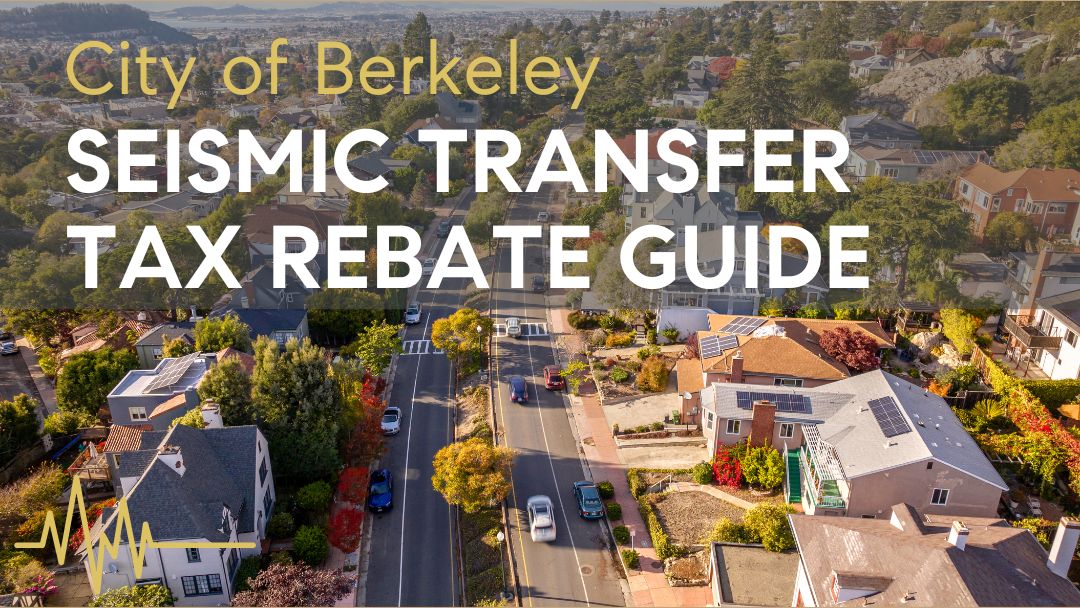Berkeley is well-known for its commitment to safety, sustainability, and community resilience. With its unique geological landscape, however, comes a heightened risk of earthquakes, making seismic safety a priority for residents and city officials alike. To encourage property owners to enhance the earthquake resilience of their buildings, Berkeley offers a Seismic Retrofit Rebate Program. This program allows homeowners to apply for a refund on a portion of the city’s real estate transfer tax when they invest in qualifying seismic improvements.
In this article, I explore the details of Berkeley’s seismic transfer tax rebate, explain how buyers can take advantage of this opportunity, and provide an example to illustrate potential savings. Understanding this program can be a strategic advantage for homebuyers, both to enhance property value and improve long-term safety.
What Is the Berkeley Seismic Transfer Tax Rebate?
The Seismic Retrofit Rebate Program provides homeowners with a rebate of up to one-third of Berkeley’s standard 1.5% real estate transfer tax for funds spent on seismic retrofitting and related improvements. This rebate aims to reduce the financial burden on homeowners undertaking seismic upgrades, thus promoting broader adoption of earthquake-resilient practices within the city. Importantly, the rebate is only available for voluntary seismic strengthening projects on buildings intended primarily for residential use.
The rebate applies to expenses incurred on qualifying seismic work, such as:
- Bolting foundations to mudsills
- Installing shear walls to improve lateral stability
- Repairing or replacing substandard foundations
- Securing or removing unreinforced masonry chimneys
- Bracing cripple walls to prevent collapse
- Anchoring water heaters
These upgrades collectively improve a building’s ability to withstand seismic forces, making it safer for occupants and increasing its structural integrity during earthquakes.
How the Seismic Transfer Tax Rebate Works for Home Buyers
When purchasing a home in Berkeley, buyers and sellers typically split cost of the base 1.5% transfer tax to the city for homes that sell for up to $1.6 million. Homes that sell above the $1.6 million threshold are charged a 2.5% transfer tax. This transfer tax is calculated based on the home’s purchase price, adding to the total closing costs of the property. However, if buyers invest in qualifying seismic retrofitting within a specific time frame (typically one year), they can apply for a rebate of up to one-third of this base 1.5% tax. This rebate serves as an incentive for new property owners to make early investments in seismic safety.
To claim the rebate, buyers need to:
- Plan and Confirm: Before starting work, buyers should contact Berkeley’s Building & Safety Division to confirm eligibility for the planned improvements. Not all projects qualify, and it’s crucial to ensure compliance with city requirements.
- Obtain Permits: Buyers must secure the necessary permits specific to seismic retrofitting, indicating on the application that the work is intended for transfer tax rebate eligibility.
- Complete and Inspect Work: After completing the retrofitting work, homeowners need to schedule and pass a series of inspections to verify that the work aligns with approved plans and standards.
- Submit the Rebate Application: Once all work is completed and approved, buyers can submit the Seismic Retrofit Rebate Application, along with receipts for the seismic work, to the Berkeley Building & Safety Division for processing.
This process provides a streamlined way for new property owners to enhance the safety of their investment while recouping a significant portion of the transfer tax paid at the time of purchase.
Example of Seismic Transfer Tax Savings on a $2,000,000 Home
To better understand the financial impact, let’s look at a practical example. Suppose a buyer purchases a home in Berkeley for $2,000,000. Here’s how the seismic transfer tax rebate would play out in terms of potential savings:
- Calculate the Transfer Tax: At Berkeley’s base 1.5% transfer tax rate, the tax owed on a $2,000,000 home would be: $2,000,000 x .015 = $30,000
- Determine Eligible Rebate Amount: With the Seismic Retrofit Rebate Program, the buyer can apply for a rebate of up to one-third of this transfer tax if they invest in qualifying seismic upgrades. In this case: Thus, the buyer could potentially receive a rebate of $10,000.
- Out-of-Pocket Seismic Costs: To claim this rebate, the buyer would need to complete qualifying seismic work, which can vary significantly in cost depending on the scope of the project. For instance, basic foundation bolting and chimney bracing might cost around $5,000 – $15,000. Comprehensive retrofitting on a larger home could exceed $20,000.
Benefits of the Seismic Transfer Tax Rebate for Home Buyers
In addition to the obvious financial savings, there are several compelling benefits for home buyers considering the seismic transfer tax rebate:
- Increased Safety: By investing in seismic retrofitting, homeowners reduce the risk of severe structural damage in the event of an earthquake, ensuring better safety for occupants.
- Long-Term Property Value: Homes with seismic upgrades are generally seen as more valuable in regions prone to earthquakes, potentially enhancing resale value and attracting buyers who prioritize safety.
- Insurance Savings: Some insurance providers offer lower premiums for homes that meet specific seismic safety standards. While this might vary, it’s worth exploring if seismic retrofitting can reduce insurance costs.
- Contribution to Community Resilience: By improving individual property resilience, homeowners contribute to Berkeley’s overall safety and disaster preparedness, aligning with city-wide goals for resilience and sustainability.
Important Considerations for Home Buyers
While the rebate program offers substantial benefits, buyers should keep a few things in mind:
- Eligibility and Pre-Approval: Not all seismic improvements qualify for the rebate. It’s essential to consult with Berkeley’s Building & Safety Division before starting any work to ensure the project will meet rebate criteria.
- Upfront Investment: Although the rebate can offset a significant portion of the transfer tax, seismic retrofitting requires an upfront investment. Buyers should budget for these costs as part of their post-purchase expenses.
- Timing and Paperwork: Buyers need to follow a structured process, from obtaining permits to completing inspections and submitting paperwork. Missing any step could result in ineligibility for the rebate, so it’s crucial to stay organized and work closely with contractors and city officials.
- Rebate Amount Cap: The rebate is capped at one-third of the 1.5% transfer tax, meaning it covers up to $10,000 in our example of a $2,000,000 home. Any additional seismic costs beyond the rebate cap will be the homeowner’s responsibility.
Conclusion: A Strategic Opportunity for Safety and Savings
For home buyers in Berkeley, the Seismic Retrofit Rebate Program is a valuable tool for enhancing property safety while reducing the transfer tax burden. By proactively investing in seismic upgrades, buyers can protect their new homes from earthquake risks, increase property value, and save on taxes. This program not only empowers individual homeowners but also contributes to the resilience of the entire Berkeley community.
Whether you’re a first-time homebuyer or an experienced investor, exploring the seismic transfer tax rebate can be a savvy move. As with any home improvement project, thorough planning, clear communication with the city, and attention to detail will maximize both the safety and financial benefits of your investment. For more information or seismic vendor recommendations, reach out to me for a personalized consultation.




